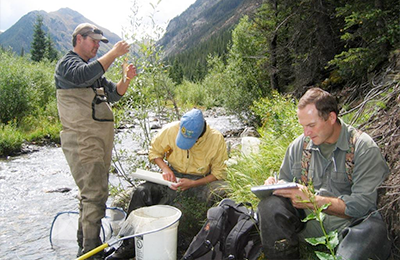Endocrine Disruption
|
Gathering Evidence
- The Scientific Process
- Skepticism and Flexibility
- It Keeps Happening
- Evidence for Endocrine Disruption
- The EDC Controversy
- Future Directions
- References
The Scientific Process
 Science provides an organized way to answer questions and find natural explanations about the world. Because of scientific research, we have a rudimentary understanding of how endocrine disrupting chemicals (EDCs) can alter hormones and other endocrine functions and affect health. Through science, we continue to learn and understand how EDCs function. Science provides an organized way to answer questions and find natural explanations about the world. Because of scientific research, we have a rudimentary understanding of how endocrine disrupting chemicals (EDCs) can alter hormones and other endocrine functions and affect health. Through science, we continue to learn and understand how EDCs function.
CAPTION: Researchers, like these analyzing DNA sequence reactions, follow the scientific method in their quest to understand the natural world. CREDIT: Wikimedia
The science process, and its governing rules of the scientific method, developed from our ancient curiosity to understand ourselves, the world, and the universe. Today, the scientific method still provides a time-tested, coordinated way to gather information or evidence that supports, explains, or disproves an original prediction or hypothesis. Rarely do true or false/right or wrong answers emerge in isolation. Rarely are cause and effect proven rapidly and without periods of doubt. Rarely is the process quick or immediate. But, over time, enough evidence may be gathered to support and explain the biological or physical event in question.
Good science, though, involves more than curiosity. Researchers must use their knowledge, interest, creativity, imagination, and logic to build on past results. In their work, they are guided by, and rely upon, the scientific method, which involves:
- developing an idea by questioning or wondering how something works
- forming a hypothesis (a prediction or an explanation that answers the question)
- testing the prediction (designing and running experiments), and
forming a conclusion (analyzing data and publishing results).
For example, James Watson, Francis Crick, and Maurice Wilkins used the scientific method to piece together the chemical structure and double-helix shape (two spiral staircases twisted together) of DNA, or deoxyribonucleic acid. They formed their double-helix hypothesis after studying results from earlier chromosomal and x-ray diffraction studies. Years of experiments tested and confirmed the prediction, which won them the 1962 Nobel Prize for physiology and medicine and led to modern genetics.
Skepticism and Flexibility
After data are gathered and analyzed, scientists publicize new findings in journals or at meetings.
Several checks and balances ensure scientific quality. Foremost of these is skepticism. Researchers review new findings with a critical eye looking for sound conclusions based on the available evidence. Healthy suspicion is important because, like in any human endeavor, wrong conclusions can be drawn, vital information can be overlooked, or experiments can be faulty.
To ensure scientific quality, results are usually peer reviewed, or scrutinized by other experts in the field, before being published in peer-reviewed journals. Unpublished results can be presented at scientific meetings where colleagues question and criticize the study’s methods and conclusions.
Once publicized, scientists with differing views and interests debate the data at meetings, in scientific journals, and through the media. Sometimes, other scientific groups repeat the experiments to validate results.
If the research holds up to scrutiny, the scientific process is flexible enough to embrace the new conclusions and modify or change theories to more accurately represent what is now known about the subject.
It Keeps Happening
For example, the discovery of microscopic spores and eggs in the 17th century explained how maggots got into decaying flesh, putting an end to the theory of spontaneous generation (animals and plants emerge spontaneously from other matter). In the early 1970s, geologists replaced all other theories and embraced the theory of plate tectonics to explain continental drift and other geological activity. The discovery that chromosomes carry genetic information in the pattern of DNA's nucleotide subunits (made up of sugars, phosphates, and nitrogen-containing base rings) revolutionized genetics and replaced the belief that chromosomes were made from protein.
In some cases, the research doesn't hold up and ideas are abandoned. For instance, in 1989, two chemists declared they had done something nobody thought was possible: fusion at room temperature. Fusion, the union of atom nuclei, usually occurs only at very high temperatures, like those inside the sun or during an atomic explosion. Although the research received tremendous attention from scientists and the public, the claims were eventually dismissed because no one could reproduce the results.
Currently, endocrine disrupting chemicals and global climate change are under scrutiny. The scientific, political, and public debates will no doubt continue as more evidence accumulates and adds to our knowledge about their pervasiveness, causes, effects, and prevention.
It is sometimes difficult to understand how experts can disagree about what data mean. Or how one study can contradict another study's findings. But, uncertainty, differing opinions, and conflicting evidence are part of the scientific process. By letting others critique experiments, conclusions, and implications, ideas are challenged, knowledge is gained and, hopefully, a better, more accurate understanding is reached.
Evidence for Endocrine Disruption
 Everything from ecosystems to molecules is studied to answer perplexing questions. One looming conundrum is endocrine disruption. How do synthetic chemicals and natural compounds interfere with hormones? How do environmental disrupters (EDs) affect the endocrine, immune, and neurological systems and with what, if any, health consequences? Everything from ecosystems to molecules is studied to answer perplexing questions. One looming conundrum is endocrine disruption. How do synthetic chemicals and natural compounds interfere with hormones? How do environmental disrupters (EDs) affect the endocrine, immune, and neurological systems and with what, if any, health consequences?
To find answers, researchers gather evidence through wildlife studies, laboratory experiments (cells, tissues, and animals), observations and anecdotal reports, and human clinical and health trend data.
CAPTION: Wildlife studies have provided some of the strongest evidence for endocrine disruption.
CREDIT: U.S. Department of the Interior, BLM.
Wildlife studies and laboratory animal research
Wildlife provided some of the first persuasive evidence of endocrine disruption and some of the first hints about how EDCs interfere. For instance, wildlife embryos, juveniles, and adults exposed to estrogenic contaminants show lifetime health effects such as abnormal genitals, increased mortality, and lower fertility (Guillette 1995; Hayes et al. 2003; Jobling et al. 2002a, 2002b; Stoker et al. 2003).
Laboratory experiments
Laboratory tests - known as assays - and animal studies gauge a chemical's endocrine disrupting capability, or its ability to interfere with normal hormone function. Different assays measure the many ways a compound can meddle in steroid hormone and thyroid hormone traffic and function (O’Connor 2002; US EPA 2005). These tests determine:
- if EDCs bind to the hormone receptor site
- if they activate specific steroid or thyroid hormone-regulated genes that make proteins
- if they cause specific kinds of cells or tissues to grow or enlarge
- if they accelerate, delay, or prevent critical life changes, such as puberty or tadpole to frog metamorphosis
- if they change blood levels of hormones made by the brain, pituitary, and endocrine glands.
 No one assay can test all of these at the same time. However, many compounds are identified as estrogenic, antiestrogenic, antiandrogenic, or antithyroid based on one or more of them. No one assay can test all of these at the same time. However, many compounds are identified as estrogenic, antiestrogenic, antiandrogenic, or antithyroid based on one or more of them.
Examples include DDT, polychlorinated biphenyls (PCBs), nonylphenols, phthalates, and synthetic hormones, which are used as pesticides, as industrial coolants, in detergents, as plastic softening agents, and in pharmaceuticals. DDT and PCBs persist in the environment, while the other synthetics are widely used in consumer products.
CAPTION: Laboratory experiments using a variety of approaches, including cell cultures and assays, can help decipher how endocrine disrupters work at the molecular level.
Observations and anecdotal reports
Carefully looking at evidence and finding patterns is another way of pinpointing EDC effects. While examining 20 years of scientific literature dealing with wildlife populations near the Great Lakes, researcher Theo Colborn noticed many physical abnormalities, higher death rates in the young, and decreasing populations in many kinds of animals, especially top-of-the-food-chain predators. After tests confirmed high levels of synthetic chemicals in wildlife tissue samples, she theorized the increasing health problems she saw in the animals were linked to human-made chemicals (Colborn et al. 1993).
Human clinical and health trend data
Hardest of all is finding evidence for human effects since it is illegal and unethical to experiment on people. Researchers called epidemiologists focus on populations and use human health data collected at medical clinics and through surveys to find health trends - such as infertility or increased cancer rates - and uncover their potential causes.
The decade-long debate over declining human sperm quality is a case in point. A 1992 study evaluating human sperm quality used 40 years of data gathered from clinics around the world. Researchers found a statistically significant trend towards lower sperm quality (lower volume, numbers and motility) that could be linked to environmental estrogens (Carlsen et al. 1992; Sharpe and Skakkenbaek 1993). In response, other scientists published contrary clinical data studies directly challenging the idea that declining sperm quality is pervasive in the modern world (Safe 1995). Further studies definitely confirmed significant declines in human sperm quality in Europe and North America but not in other world regions (Swan et al. 1997, 2000, 2003a). International efforts to track human sperm quality and to investigate potential causes of significant declines revealed that environmental exposure to some chemicals is strongly associated with low sperm quality (Duty et al. 2003; Hauser et al. 2003; Swan et al. 2003b).
The EDC Controversy
Scientific evidence is not always straightforward and certain, especially with complex biological systems. That's why skepticism and flexibility are built into the scientific process. Once data are published, other scientists review the findings and agree with or challenge the author's conclusions. The review process leads to scientific and public debates that help to shape our understanding of science and interpret, apply, and use scientific results.
The issue of EDCs is no exception. Its complexities lend itself to controversy. Debates center around which chemicals, in what combinations, at what doses, and exposed at what ages may cause what health problems. Can the risks be estimated and contained?
Some believe that research studies prove there are real and dangerous health effects for wildlife and humans. Others admit there may be health effects but think the results are only applicable to wildlife, and even then, only where high doses exist. They also acknowledge the need for further scientific verification. Still others believe the results are sketchy, mainly correlative, and without substance. back to top
Future Directions
Less overt, long-term health threats - like those posed by EDCs - are modifying the way we define toxicity and determine public health risk. Finding answers to increasingly complicated and interrelated problems with environmental, health, economic, and political consequences is no easy matter. In response, regulatory agencies, industry, and universities are devoting time, money, and research to learn how and to what degree EDCs affect wildlife and human health.
One step underway is to develop a series of screening and testing protocols for chemicals. The goal of endocrine disrupter screening and testing programs is to identify chemicals that act on the endocrine system and cause adverse health effects in wildlife or humans. Governments can use the results to restrict or ban chemicals to protect the environment and public health. The US Environmental Protection Agency, the European Union , Japan’s Ministry of Environment, and the Organization for Economic Cooperation and Development are developing testing programs.
In addition, ongoing research efforts to better understand long-term health effects continues to:
- identify the compounds and validate reliable and sensitive assay systems
- determine related health effects
- understand how individual differences, like age, dose, length of exposure and genetics, determine health effects
- find out how multiple synthetic chemicals react with each other in the body and the environment
References
- Colborn T, vom Saal FS, and Soto AM. 1993. Developmental effects of endocrine-disrupting chemicals in wildlife and humans. Environmental Health Perspectives 101:378-384.
- Carlsen E, Giwercman A, Keiding N, and Skakkebaek NE. 1992. Evidence for decreasing quality of semen during past 50 years. British Medical Journal 305:609-613.
- Duty S, Silva M, Barr D, Brock J, Ryan L, Chen Z, Herrick R, Christiani D, and Hauser R. 2003. Phthalate exposure and human semen parameters. Epidemiology 14:269-277.
- Guillette L. 1995. Endocrine disrupting environmental contaminants and developmental abnormalities in embryos. Human and Ecological Risk Assessment 1:25-36.
- Hauser R, Chen Z, Pothier L, Ryan L, and Altshul L. 2003. The relationship between human semen parameters and environmental exposure to polychlroinated biphenyls and p,p’-DDE. Environmental Health Perspectives 111:1505-1511.
- Hayes T, Hason K, Tsui M, Hoang A, Haeffele C, and Vonk A. 2003. Atrazine-induced hermaphroditism at 0.1 ppb in American leopard frogs (Rana pipiens): Laboratory and field evidence. Environmental Health Perspectives 111:568-575.
- Jobling S, Beresford N, Nolan M, Rodgers-Gray T, Brighty G, Sumpter J, and Tyler C. 2002a. Altered sexual maturation and gamete production in wild roach (Rutilus rutilus) living in rivers that receive treated sewage effluents. Biology of Reproduction 66:272-281.
- Jobling S, Coey S, Whitmore J, Kime D, VanLook K, McAllister B, Beresford N, Henshaw A, Brighty G, Tyler C, and Sumpter J. 2002b. Wild intersex roach (Rutilus rutilus) have reduced fertility. Biology of Reproduction 67:515-524.
- O'Connor J, Cook J, Marty M, Davis L, Kaplan A, and Carney E. 2002. Evaluation of Tier I screening approaches for detecting endocrine active compounds (EACs). Critical Reviews in Toxicology 32:521-549.
- Safe S. 1995. Do environmental estrogens play a role in development of breast cancer in women and male reproductive problems? Human and Ecological Risk Assessment 1(2):17-23.
- Sharpe R and Skakkenbaek NE. 1993. Are oestrogens involved in falling sperm counts and disorders of the male reproductive tract? Lancet 341:1392-95.
- Stoker C, Rey F, Rodriguez H, Ramos J, Sirosky P, Larriera A, Luque E, and Munoz-de-Toro M. 2003. Sex reversal effects on Caiman latirostris exposed to environmentally relevant doses of the xenoestrogen bisphenol A. General and Comparative Endocrinology 133:287-296.
- Swan SH, Elkin EP, and Fenster L. 1997. Have sperm densities declined? A reanalysis of global trend data. Environmental Health Perspectives 105:1228-1232.
- Swan S, Elkin E, and Fenster L. 2000. The question of declining sperm density revisited: An analysis of 101 studies published 1934-1996. Environmental Health Perspectives 108:961-966.
- Swan S, Brazil C, Drobnis E, Liu F, Kruse R, Hatch M, Redmon J, Wang C, Overstreet J, and Study for Future Families Research Group. 2003a. Geographic differences in semen quality of fertile US males. Environmental Health Perspectives 111:414-420.
- Swan S, Kruse R, Liu F, Barr D, Drobnis E, Redmon J, Wang C, Brazil C, Overstreet J, and Study for Future Families Research Group. 2003b. Semen quality in relation to biomarkers of pesticide exposure. Environmental Health Perspectives 111:1478-1484.
- US EPA (Environmental Protection Agency). 2005. Assay Status Table, Endocrine Disruptor Screening Program.
|


